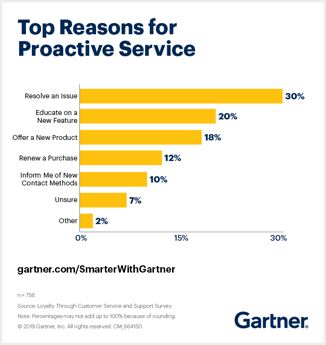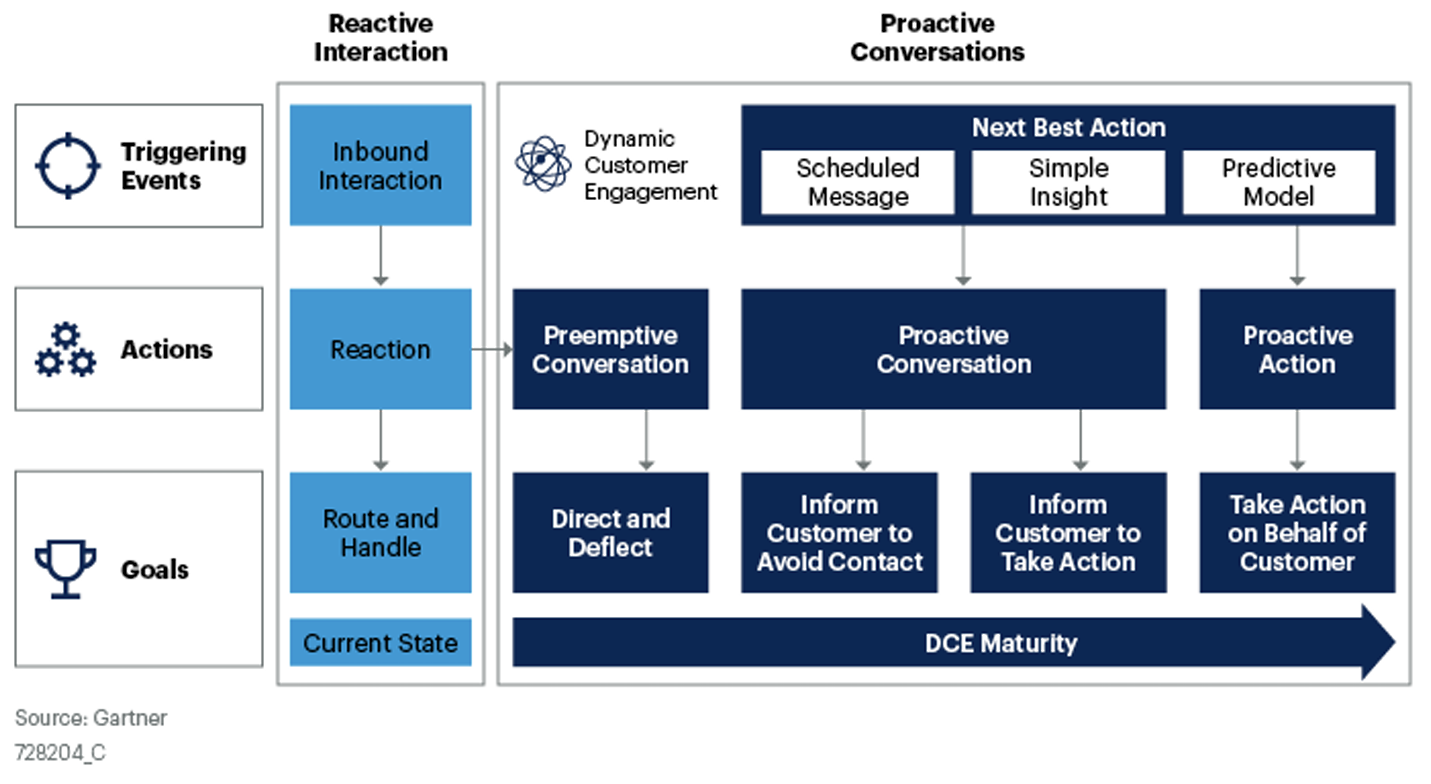Customer service and Customer Experience (CX) are at the heart of every successful business. While they are distinct concepts, they share a common goal: to enhance the overall customer journey.
In this article, you will learn the difficulties and common goals of CX and customer service management, including practical use cases.
1. Introduction to Customer Service and Experience
Customer service can be defined as the support provided to customers, addressing their needs and concerns. It can be further categorized into reactive and proactive customer service. Reactive service involves responding to customer issues, while proactive service anticipates customer needs and provides solutions even before problems arise.
Use Case: In the insurance industry, consider a policyholder with a home insurance policy. In a proactive customer service scenario, the insurance company uses advanced weather data and predictive analytics to identify an approaching severe storm that could potentially damage the policyholder's area. The company proactively contacts the policyholder, offering advice on how to protect their property and providing information on expedited claims processing should any damage occur.
In a reactive scenario, the insurance company waits for the policyholder to report damage after the storm has hit. They then initiate the claims process, which may result in delayed assistance and prolonged inconvenience for the policyholder.
The proactive approach not only enhances the customer's overall experience but also demonstrates the insurer's commitment to their safety and well-being, while the reactive approach may result in added stress and uncertainty for the policyholder.
2. Parallels Between Customer Service and CX
2.1. Shared Objectives
One of the key parallels between customer service and CX is their shared objectives. Both aim to foster customer loyalty and retention, enhance brand reputation, and build trust. They serve as the foundation for sustainable business growth. When customers have positive experiences, they are more likely to return and recommend the brand to others.
Scenario 1: CX Team
In the headquarters of a retail giant, the CX team is hard at work. They're analyzing customer feedback, conducting surveys, and studying customer behavior on the company's website. Their goal is to identify pain points in the online shopping experience. Through their research, they've discovered that many customers abandon their shopping carts just before completing a purchase, and this has been a recurring issue.
They immediately put in place a plan to improve the online shopping experience. They work on optimizing the website's navigation, simplifying the checkout process, and enhancing product recommendations. Their approach is proactive, focusing on making the customer journey smoother and more enjoyable. The team also devises a strategy to communicate these changes effectively to the customers.
Scenario 2: Customer Service Department
At the same time, in a call center located in a different city, the Customer Service department is handling a high volume of customer inquiries and issues. Customers are calling in with questions about the website's functionality, difficulties during the checkout process, and concerns about the security of online transactions. The department is dedicated to providing solutions and resolving these issues as efficiently as possible.
While addressing customer concerns, they realize that many customers express their frustration about the same problems the CX team identified. The customer service representatives actively listen to customer feedback, take notes of recurring issues, and communicate these findings back to the CX team at the headquarters.
Common Goal:
Both the CX team and the Customer Service department are working toward the same goal: improving the overall customer experience. While the CX team is focused on addressing these issues proactively, the Customer Service department is addressing them reactively, in real-time, when customers encounter problems.
The crucial link between these two scenarios is communication and collaboration. The customer service representatives act as frontline data gatherers, sharing real customer experiences and pain points with the CX team. This partnership ensures that the company can proactively make website improvements while also providing immediate support and solutions to customers. It exemplifies how different departments within a company, although working in distinct ways, ultimately contribute to the same overarching goal of enhancing the customer experience.
2.2. Differences Between Customer Service and CX
While the objectives align, there are distinct differences between customer service and CX. Customer service is a subset of CX, focusing on specific touchpoints in the customer journey. In contrast, CX encompasses the entire journey, from the initial brand awareness to post-purchase follow-up. It is about understanding and improving all interactions customers have with a brand.
Use Case: In the automotive industry, imagine a customer who contacts a car manufacturer's customer service department with a technical issue. The customer service team efficiently addresses the problem, provides guidance, and ensures that the vehicle's issue is resolved promptly.
However, what truly differentiates this automotive manufacturer is its commitment to holistic Customer Experience Management (CX). While the customer service team excels in addressing the immediate technical concern, the broader realm of CX comes into play to create a memorable journey.
Throughout the process, the customer receives proactive updates on various aspects of their ownership experience. These updates extend beyond the technical issue resolution and include reminders for scheduled maintenance, notifications about the latest software updates, and personalized suggestions for enhancing the vehicle's performance and comfort.
This comprehensive customer experience in the automotive industry showcases the distinction between customer service and experience management. Customer service takes care of resolving specific issues efficiently, but CX expands beyond these individual interactions to encompass the entire ownership journey. It leverages proactive strategies to keep customers engaged, informed, and delighted throughout their ownership experience.
This use case illustrates how, in the automotive industry, the synergy between customer service and CX management can create an outstanding customer experience. While customer service ensures technical problem-solving, CX goes further by nurturing the customer's relationship with the brand and delivering a seamless and value-added journey from the moment of vehicle purchase to long-term ownership.
2.3. Exploring the Challenges of Aligning Customer Service and Customer Experience Goals
Aligning customer service and customer experience goals and tools can be a complex process and may face various challenges. Here are some potential difficulties:
- Silos and Departmental Barriers: In many organizations, customer service and customer experience are managed by different departments or teams. This can create silos, making it challenging to coordinate efforts and align goals.
Example: In a large retail chain, the CX team and Customer Service department operate independently. They rarely share insights from customer interactions, making it difficult to create a cohesive and holistic customer experience. - Differing Metrics: Customer service teams often focus on metrics like response time and issue resolution, while customer experience encompasses a broader range of metrics such as NPS and customer satisfaction. Aligning these varying metrics can be difficult.
Example: An online streaming service measures customer service success based on issue resolution times, while the CX team focuses on NPS and customer journey satisfaction. This mismatch in metrics can lead to misaligned objectives and strategies. - Technology Integration: Integrating the tools and systems used by customer service and CX teams can be complex. Ensuring that data flows seamlessly between these systems is crucial for a holistic view of the customer journey.
Example: An e-commerce company uses separate platforms for customer service inquiries and CX analytics. This disjointed approach hinders their ability to gain a comprehensive view of the customer journey and react in real-time. - Training and Skillset: Customer service representatives may need different training and skillsets compared to CX professionals. Aligning the skill development and training needs of these teams can be a challenge.
Example: In a luxury hotel chain, the customer service staff is trained to deliver exceptional in-person experiences, while the CX team specializes in improving the online booking process. Aligning these distinct skillsets can be a challenge. - Cultural Shift: A customer-centric culture is essential for aligning these goals. Achieving this shift in mindset and values across the organization may require time and effort.
Example: An established tech company decides to become more customer-centric. However, instigating a cultural shift across various departments takes time and commitment, especially when some employees are accustomed to a different corporate culture. - Data Accessibility: Ensuring that customer data is accessible and shared between teams while adhering to privacy regulations can be challenging.
Example: A healthcare provider collects valuable patient experience data, but limitations in data accessibility and sharing between the CX and Customer Service teams hinder their ability to enhance the overall patient journey. - Balancing Proactivity and Reactivity: Customer service is often reactive, while CX may involve proactive strategies. Finding the right balance between being responsive to immediate customer needs and proactively enhancing the overall experience is a challenge.
Example: A telecommunications company's customer service team focuses on handling billing inquiries reactively, while the CX team is responsible for proactively identifying opportunities for personalized service. Finding the right balance between these approaches can be challenging. - Resource Allocation: Both customer service and CX initiatives require resources. Deciding on the allocation of budgets and manpower between these areas can be a source of tension.
Example: A technology startup faces tension when deciding how to allocate budgets and manpower between their Customer Service and CX initiatives. This leads to debates about the prioritization of resources for customer-centric strategies. - Change Management: Aligning these goals often involves changes in processes, roles, and responsibilities. Change management can be challenging and met with resistance from employees.
Example: A retail fashion brand initiates a transformation to become more customer-focused. However, employees are resistant to changes in their roles and responsibilities, which slows down the alignment of Customer Service and CX efforts. - Consistency Across Channels: Providing a consistent experience across various customer touchpoints, including digital and in-person, can be a struggle, especially when multiple teams are involved.
Example: An airline offers exceptional in-flight service but struggles to maintain a consistent level of service quality on its mobile app and website, resulting in varying customer experiences across different touchpoints. - Measuring and Monitoring: Ensuring that the tools used for measuring and monitoring customer service and CX align with the organization's overall objectives can be a challenge.
Example: An online marketplace uses separate tools for monitoring customer service interactions and tracking overall CX performance. These tools do not align with the company's overarching objectives, making it challenging to analyze the collective impact of customer interactions on the overall experience.
Admitting that these difficulties might pose a significant challenge for CX managers and teams when adopting experience management in their organizations, it's essential to recognize the importance of persevering through these obstacles. While the path to alignment and collaboration between customer service and CX efforts can be challenging, the benefits are substantial.
To overcome these difficulties, organizations should prioritize clear communication, establish cross-functional teams, and foster a shared commitment to customer-centricity. By actively seeking to bridge the gap between customer service and CX, businesses can achieve a more cohesive and holistic approach to customer experience management.
Moreover, regular assessment and adaptation of strategies are vital. This allows organizations to stay agile, adjust to changing customer needs, and ensure that their efforts remain aligned with their overall objectives. In this dynamic landscape, the ability to adapt and evolve becomes a competitive advantage, ultimately leading to improved customer experiences and lasting relationships.
3. Creating Seamless Customer Experiences Through Proactive Service
Gartner points out that "Customer service has always been highly reactive. In fact, most service organizations operate in a reactive manner, requiring customers to exert significant effort to navigate multiple service channels, often unsuccessfully. Unfortunately, this leads to low self-service containment and customer dissatisfaction. Reactive service experiences place the burden on customers to find the best channel for resolution."
To truly excel in CX management, businesses must adopt proactive customer service strategies. Proactive service involves anticipating customer needs and addressing them before customers even realize there's an issue. It's about going the extra mile to surprise and delight customers.
 According to Gartner’s Loyalty Through Customer Service and Support Survey, top reason for proactive service is resolve an issue by 30%, demonstrating the highest percentage of that proactive services play a very important role in negative customer experience issues.
According to Gartner’s Loyalty Through Customer Service and Support Survey, top reason for proactive service is resolve an issue by 30%, demonstrating the highest percentage of that proactive services play a very important role in negative customer experience issues.
To truly excel in CX management, businesses must adopt proactive customer service strategies. Proactive service involves anticipating customer needs and addressing them before customers even realize there's an issue. It's about going the extra mile to surprise and delight customers.
Gartner research also reveals that a dynamic customer engagement (DCE) strategy enables customer service and support leaders to transform their service experience through personalized proactive conversations with customers.
Figure: DCE Maturity — Reactive Interactions to Proactive Conversations by Gartner

Customer service and support leaders must employ dynamic customer engagement to enable a more personalized customer experience. As John Quaglietta, Senior Director Analyst at Gartner, notes, "Shifting from reactive to proactive conversations is a game-changer, delivering nearly effortless experiences, reducing cost, and increasing customer lifetime value."
4. Measuring Success and Adapting Strategies
To assess the effectiveness of proactive customer service, it's essential to use key metrics. Customer Satisfaction (CSAT) and Net Promoter Score (NPS) are valuable indicators. High CSAT scores indicate satisfied customers, while a high NPS suggests strong brand advocacy.
Continuous improvement is also vital. Feedback loops and customer surveys help identify areas for enhancement. Businesses should actively seek customer opinions and make data-driven decisions to adapt their strategies.
Use Case: In the hospitality industry, a guest stays at a hotel and receives a post-stay survey. The survey not only asks about the room and amenities but also inquiries about the overall experience, including interactions with staff. This feedback loop enables the hotel to make continuous improvements in both customer service and the broader customer experience.
5. Conclusion
As businesses, we must invest in proactive customer service strategies that create seamless experiences and differentiate us from competitors. By continuously measuring success and adapting our approaches, we can consistently meet and exceed customer expectations and the connection between customer service and CX is undeniable. They both play pivotal roles in shaping the customer's journey and building long-lasting relationships with customers.
However, it's crucial to underscore that the foundation of any exceptional customer service experience lies in engaged employees. There's no way to create good customer service experiences without employees who are passionate, motivated, and dedicated to meeting customer needs.
Use Case: Imagine a scenario in the healthcare industry where a patient calls a medical center with a complex question about their treatment plan. The customer service representative not only provides accurate information but also demonstrates empathy and a genuine commitment to the patient's well-being. In this context, the employee's engagement directly impacts the patient's experience, ensuring trust and satisfaction in the healthcare provider.
In every industry, engaged employees play a pivotal role in closing the loop capabilities of every CEM landscape, ensuring that customers receive exceptional service and memorable experiences.
6. How Pisano can help you to provide better customer service experience?
Pisano seamlessly aligns customer service and customer experience by directly addressing the challenge of information flow between different departments to create a great customer service experience.
- Pisano’s ticket management and reporting tools play a pivotal role in fostering a culture of collaboration. With a centralized inbox, team members can effortlessly track, assign, tag, and collaborate to resolve issues promptly, ensuring seamless customer experiences regardless of the source – be it the Customer Service department via a phone call or the CX department's strategic initiatives.
- Pisano empowers companies to adopt a proactive service approach by leveraging advanced behavioral insights across digital channels. Understanding the origin of customer interactions, their specific needs, and how to assist them effectively helps enable companies to anticipate customer requirements and provide personalized solutions.
- Pisano goes a step further by facilitating seamless data synchronization and easy integrations of various technology tools, consolidating all resources in one accessible platform. This integration not only enhances operational efficiency but also eliminates data silos within the organization.
This approach not only enhances customer satisfaction but also fosters loyalty, making Pisano an invaluable partner in delivering exceptional customer service experiences and guaranteeing a cohesive customer journey.
7. Additional Resources
- Source 1: Understanding the Difference Between Customer Service and CX
- Source 2: How Proactive Customer Service Will Transform Customer Experience
- Source 3: Know the Difference between Customer Service and Customer Experience
Get Started on Your Experience Management Journey with Pisano Now
Unlock the art of customer service succes and provide seamless customer experiences in digital and offline touchpoints.




